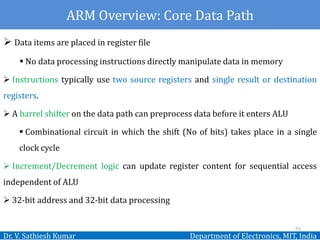The document covers the design and functionality of embedded systems, emphasizing the integration of hardware and software along with the challenges in meeting real-time performance and energy efficiency. It discusses the historical development of embedded computing, the components involved, and various design methodologies, including requirement analysis, specification, and integration processes. Additionally, it introduces UML as a modeling language to facilitate effective system design and highlights the importance of programmability in microprocessors.













































































![Dr. V. Sathiesh Kumar Department of Electronics, MIT, India
Depending upon context, register r13 and r14 can also be used as
GPR
Any instruction which use r0 can as well be used with any other
GPR (r1-r13)
In addition, there are two status registers
CPSR: Current Program Status Register
SPSR: Saved Program Status Register
Register r15 (Program counter)
All instructions are 32 bit wide and word aligned
PC value is stored in bits [31:2] with bits [1:0] undefined
78
Registers- Continued](https://image.slidesharecdn.com/unitiintroductiontoembeddedcomputingandarmprocessor-170416074544/85/Unit-1-Introduction-to-Embedded-computing-and-ARM-processor-78-320.jpg)

















![Dr. V. Sathiesh Kumar Department of Electronics, MIT, India
Multiply contents of a pair of registers.
Long multiply generates 64 bit result.
Eg., MUL r0, r1 , r2 (32 bit result) r0=r1*r2
Contents of r1 and r2 multiplied and put in r0.
Eg., UMULL r0 , r1 , r2, r3 (64 bit result) [r0, r1]=r2*r3
Unsigned long multiply with result stored in r0 and r1.
No. of cycles taken for execution of multiply instruction depends
upon processor implementation.
96
Multiply Instructions](https://image.slidesharecdn.com/unitiintroductiontoembeddedcomputingandarmprocessor-170416074544/85/Unit-1-Introduction-to-Embedded-computing-and-ARM-processor-96-320.jpg)
![Dr. V. Sathiesh Kumar Department of Electronics, MIT, India
Result of multiplication can be accumulated with contents of
another register.
Eg., MLA Rd , Rm , Rs , Rn (32 bit result) [Convolution Operation]
Rd = (Rm* Rs ) + Rs
Eg., UMLAL Rdlo , Rdhi , Rm , Rn (64 bit result)
[Rdhi , Rdlo ]= [Rdhi , Rdlo ]+ (Rm* Rn)
97
Multiply and Accumulate](https://image.slidesharecdn.com/unitiintroductiontoembeddedcomputingandarmprocessor-170416074544/85/Unit-1-Introduction-to-Embedded-computing-and-ARM-processor-97-320.jpg)



![Dr. V. Sathiesh Kumar Department of Electronics, MIT, India
Load and store data on a boundary alignment.
LDR , LDRH , LDRB (Load- Word, Half word, Byte)
STR , STRH , STRB (Store – Word, Half word, Byte)
Support different addressing modes
Register indirect: LDR r0, [r1]
Immediate: LDR r0, [r1, #4] (12-bit offset added to the base register)
Register operation: LDR r0, [r1,-r2] (Address calculated using base
register and another register)
Scaled (Address is calculated using the base address register
and a barrel shifter operation)
Pre & Post indexing 101
Single Transfer Instructions](https://image.slidesharecdn.com/unitiintroductiontoembeddedcomputingandarmprocessor-170416074544/85/Unit-1-Introduction-to-Embedded-computing-and-ARM-processor-101-320.jpg)
![Dr. V. Sathiesh Kumar Department of Electronics, MIT, India
Pre-index with write back: LDR r0,[r1, #4]! (Updates the
address base register with new address)
Post-index: LDR r0, [r1], #4 (Updates the address register
after address is used)
Eg: Pre-indexing with write back: LDR r0, [r1, #4]!
Before instruction execution After instruction execution
r0=0x00000000, r1=0x00009000 r0=0x02020202, r1=0x00009004
Mem 32[0x00009000]=0x01010101
Mem 32[0x00009004]=0x02020202
102
Single Transfer Instructions-Pre & Post Indexing](https://image.slidesharecdn.com/unitiintroductiontoembeddedcomputingandarmprocessor-170416074544/85/Unit-1-Introduction-to-Embedded-computing-and-ARM-processor-102-320.jpg)
























